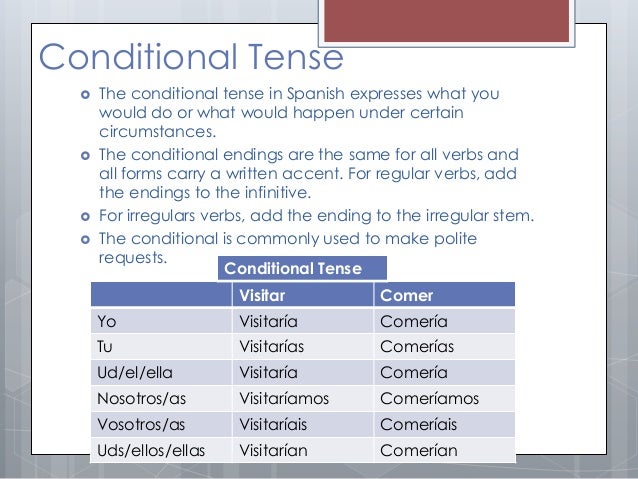


Qu hora sera What time could it have been Estara en su casa. The student said that he would study one more hour. El alumno dijo que estudiara una hora ms. – Si nosotros hubiésemos estado allí, le habríamos ayudado. amos ais an Here are all three regular conditional verb forms together: Here are the previous examples, translated to Spanish. We have also grouped them according to their patterns of change. Because the endings are the same as all other conditional tense verbs, we show only the yo form, and have underlined the irregular stem. (They would have told her something, if they had seen her.) Their endings are regular, but their stems change in the same way they change in the future tense. – Le habrían dicho algo si la hubieran visto. The conditional perfect is formed by using the conditional forms of the helping verb haber with the past (or passive) participle: Their endings are regular, but their stems change in the same way they change in the future tense: decir The most common verbs that are irregular in the future tense are also irregular in the conditional tense. – Vivir (to live ): Viviríamos en París si pudiésemos. – Beber (to drink ): ❻eber ías conmigo un vaso de vino? (Would you drink a glass of wine with me?) (I would sing with you if I knew the song.) – Cantar (to sing): Cantar ía contigo si supiese la canción. We use the same stem as for some other tenses, the infinitive, and the same endings as for the imperfect of -er and -ir verbs (-ía, -ías, -ía, -íamos, -íais, -ían). It is very connected to the future tense, that´s why we call it both condicional and futuro hipotético (hypothetical future). It does not only refer to a concrete moment in time (past, present or future), but it is used to express probability, possibility, wonder or conjecture. The endings are consistent for -ar, -ir, and -er verbs. The conditional tense is one of the most complicated tenses in Spanish.


 0 kommentar(er)
0 kommentar(er)
